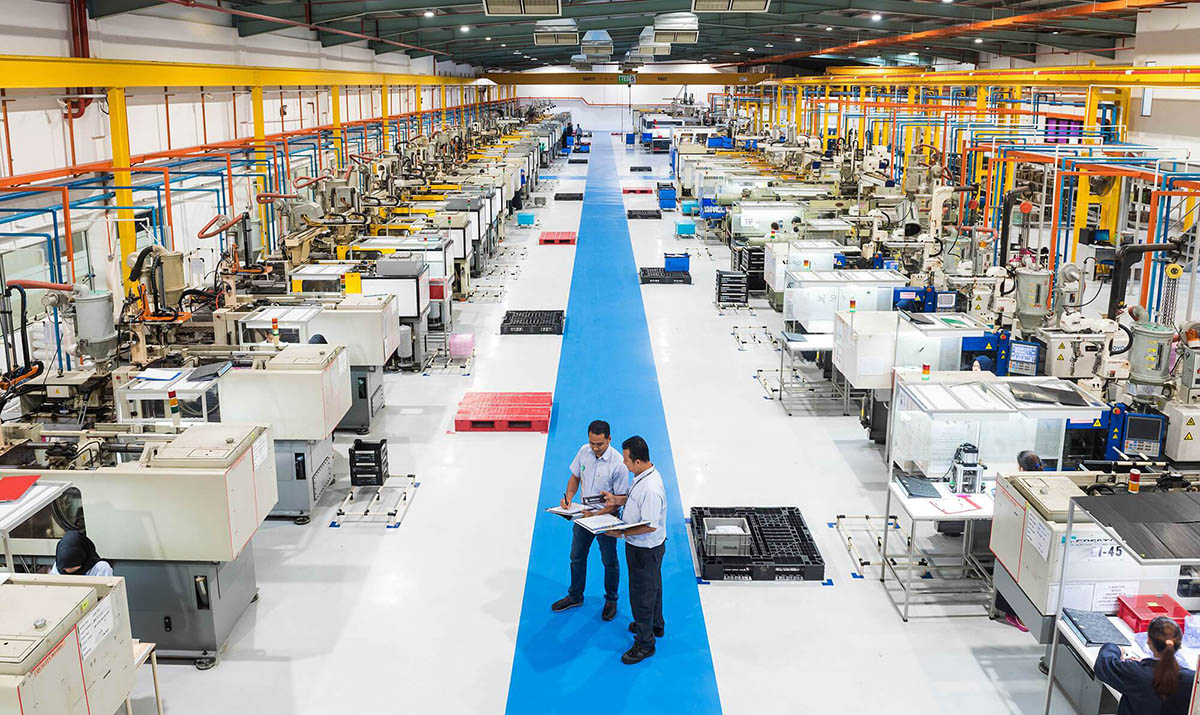

Finance
What Is Visible Supply Chain Fulfillment?
Modified: February 21, 2024
Learn how visible supply chain fulfillment can revolutionize your finance department and streamline operations for increased efficiency and profitability.
(Many of the links in this article redirect to a specific reviewed product. Your purchase of these products through affiliate links helps to generate commission for LiveWell, at no extra cost. Learn more)
Table of Contents
- Introduction
- Definition of Visible Supply Chain Fulfillment
- Benefits of Visible Supply Chain Fulfillment
- Key Components of Visible Supply Chain Fulfillment
- Importance of Visibility in Supply Chain Fulfillment
- Technology and Tools for Achieving Visible Supply Chain Fulfillment
- Challenges and Solutions in Implementing Visible Supply Chain Fulfillment
- Case Studies of Successful Visible Supply Chain Fulfillment Implementations
- Future Trends in Visible Supply Chain Fulfillment
- Conclusion
Introduction
The concept of supply chain fulfillment has undergone significant transformations in recent years. With the advent of technology and changing consumer expectations, businesses are now faced with the challenge of not just efficiently delivering goods, but also providing visibility throughout the entire supply chain process. This is where the concept of visible supply chain fulfillment comes into play.
Visible supply chain fulfillment refers to the practice of ensuring transparency and real-time visibility into every aspect of the supply chain, from the manufacturer to the end consumer. It involves leveraging technology, data, and analytics to track and monitor products, inventory, and shipments at every stage of the supply chain journey.
Traditionally, supply chain management focused on optimizing processes such as procurement, production, and distribution. However, this approach often lacked real-time visibility, leading to inefficiencies, delays, and increased costs. Visible supply chain fulfillment aims to address these challenges by providing a holistic view of the entire supply chain, enabling businesses to make informed decisions, improve operations, and ultimately enhance customer satisfaction.
In today’s fast-paced and hypercompetitive business landscape, customers expect more than just timely delivery. They want to know the status of their orders, track their shipments, and have access to accurate and up-to-date information. Visible supply chain fulfillment not only empowers businesses with the ability to meet these expectations but also enables them to gain a competitive edge in the market.
This article explores the concept of visible supply chain fulfillment, its benefits, key components, technological tools, challenges, and future trends. By diving into these aspects, businesses can gain valuable insights into how to leverage visible supply chain fulfillment and drive success in their operations.
Definition of Visible Supply Chain Fulfillment
Visible supply chain fulfillment can be defined as the practice of providing complete transparency and real-time visibility into every stage of the supply chain process, from sourcing and production to warehousing, transportation, and delivery. It involves leveraging technology, data analytics, and collaborative platforms to track and monitor the movement of goods, inventory levels, and order status throughout the supply chain network.
By implementing visible supply chain fulfillment, businesses can have a clear and comprehensive view of their entire supply chain, enabling them to make data-driven decisions, optimize operations, and enhance customer satisfaction. It goes beyond traditional supply chain management practices by emphasizing the importance of visibility and transparency in meeting customer demands and improving overall supply chain performance.
Visible supply chain fulfillment encompasses various aspects, including:
- Real-time tracking: With the help of advanced technology like IoT (Internet of Things) devices, RFID (Radio Frequency Identification) tags, and GPS (Global Positioning System), businesses can track the location and status of shipments in real-time. This allows for better coordination and proactive problem-solving.
- Inventory optimization: By having visibility into inventory levels and demand patterns, businesses can optimize their inventory management practices. This includes minimizing stockouts, reducing excess inventory, and improving order fulfillment rates.
- Collaboration and communication: Visible supply chain fulfillment emphasizes the importance of collaboration and communication among supply chain partners. Enhanced visibility enables seamless information sharing, allowing for better coordination, faster issue resolution, and improved overall efficiency.
- Customer visibility: In addition to internal visibility, visible supply chain fulfillment extends to the end customer. Customers can track their orders, receive timely updates, and have access to accurate delivery information. This fosters trust and enhances the overall customer experience.
Overall, visible supply chain fulfillment offers a comprehensive and interconnected approach to supply chain management, where visibility and transparency are prioritized at every stage. By implementing this practice, businesses can address common challenges, improve operational efficiency, and ultimately deliver a superior customer experience.
Benefits of Visible Supply Chain Fulfillment
Implementing visible supply chain fulfillment offers a range of benefits for businesses across different industries. By leveraging technology and providing real-time visibility into the supply chain process, organizations can gain a competitive advantage and improve overall operational efficiency. Here are some key benefits of visible supply chain fulfillment:
- Enhanced customer satisfaction: By providing visibility into the status of orders and shipments, businesses can meet customer expectations for transparency and timely delivery. Customers can track their orders, receive updates, and have accurate information about delivery times. This leads to higher customer satisfaction and builds trust and loyalty.
- Improved inventory management: With real-time visibility into inventory levels, businesses can optimize their inventory management practices. They can reduce stockouts by proactively replenishing inventory and avoid holding excess stock, leading to cost savings and improved order fulfillment rates.
- Efficient problem-solving: With visibility into the entire supply chain network, businesses can quickly identify and address any issues or bottlenecks that may arise. Real-time tracking enables proactive problem-solving, minimizing delays, and improving overall operational efficiency.
- Optimized logistics and transportation: Visible supply chain fulfillment enables businesses to optimize logistics and transportation operations. Real-time tracking of shipments allows for better route planning, reducing transportation costs, and improving delivery timeframes.
- Improved collaboration: Enhanced visibility facilitates better collaboration and communication among supply chain partners. Timely and accurate information sharing leads to improved coordination, reduced manual interventions, and faster issue resolution.
- Data-driven decision making: By harnessing the data generated from visible supply chain fulfillment, businesses can make more informed and data-driven decisions. They can analyze trends, identify areas for improvement, and implement strategies to optimize supply chain processes.
The benefits of visible supply chain fulfillment extend beyond internal operational improvements. They have a direct impact on customer satisfaction, cost savings, and overall business performance. By embracing the principles of visibility and transparency, businesses can drive efficiencies, improve customer relationships, and stay ahead in today’s dynamic marketplace.
Key Components of Visible Supply Chain Fulfillment
Visible supply chain fulfillment is built upon various key components that work together to provide transparency and real-time visibility into the supply chain process. These components encompass both technological solutions and collaborative practices. Here are the key components of visible supply chain fulfillment:
- Data capture and sensors: The foundation of visible supply chain fulfillment lies in capturing accurate and real-time data. This is achieved through the use of sensors such as RFID tags, IoT devices, and barcode scanners. These sensors collect data related to inventory levels, product location, and temperature and humidity conditions, providing essential information for visibility.
- Cloud computing: Cloud computing plays a crucial role in visible supply chain fulfillment by providing a centralized platform for managing and analyzing supply chain data. Cloud-based software solutions enable stakeholders to access and share real-time information from anywhere, facilitating collaboration and decision-making processes.
- Data analytics and AI: The immense amount of data collected in visible supply chain fulfillment requires advanced analytics techniques and artificial intelligence (AI) capabilities to extract valuable insights. Data analytics helps identify patterns, trends, and anomalies in supply chain data, enabling businesses to make data-driven decisions and optimize their operations.
- Collaborative platforms: Seamless collaboration and communication between supply chain partners are essential in achieving visible supply chain fulfillment. Collaborative platforms allow stakeholders to share information, coordinate activities, and resolve issues in real-time, improving overall visibility and efficiency.
- Real-time tracking and monitoring: Real-time tracking and monitoring technologies, such as GPS and RFID, enable businesses to track the movement and status of goods throughout the supply chain. This ensures accurate visibility into the location, condition, and estimated delivery times of products, enabling proactive decision-making and issue resolution.
- Integration and connectivity: Integrating different systems and ensuring connectivity across the supply chain is vital for visible supply chain fulfillment. Integration of data from various sources allows for a seamless flow of information, preventing data silos and ensuring accurate visibility across the entire supply chain network.
- Supply chain visibility tools: There are various software tools available specifically designed for visible supply chain fulfillment. These tools provide a centralized dashboard that displays real-time information about inventory, shipments, order status, and other key supply chain metrics. They enable stakeholders to monitor and manage the supply chain effectively.
These key components form the foundation of visible supply chain fulfillment, enabling businesses to achieve end-to-end visibility, make informed decisions, and optimize their supply chain operations. By implementing these components, organizations can enhance collaboration, improve customer satisfaction, and gain a competitive edge in today’s complex and dynamic business environment.
Importance of Visibility in Supply Chain Fulfillment
Visibility plays a critical role in supply chain fulfillment, as it provides businesses with a comprehensive view of their operations and enables them to make data-driven decisions. Here are key reasons why visibility is essential in supply chain fulfillment:
- Enhanced operational efficiency: Increased visibility allows businesses to identify bottlenecks, streamline processes, and optimize operations. By having real-time visibility into inventory levels, order statuses, and supply chain performance, organizations can proactively identify issues, resolve them promptly, and minimize disruptions.
- Improved customer satisfaction: In today’s competitive market, customers have high expectations when it comes to transparency and delivery experience. Visibility enables businesses to provide accurate and timely information to customers, such as order tracking and estimated delivery times. This builds trust, enhances the customer experience, and ultimately leads to higher customer satisfaction rates.
- Proactive issue resolution: With visibility into the supply chain, businesses can detect issues and address them proactively. Whether it’s a delay in production, a transportation disruption, or a stockout situation, real-time visibility enables quick action and mitigates the impact on customers and the overall supply chain.
- Optimized inventory management: Visibility into inventory levels, demand patterns, and order fulfillment rates allows businesses to optimize their inventory management practices. Accurate visibility helps in minimizing stockouts, reducing excess inventory, and improving overall inventory turnover, leading to cost savings and improved customer service levels.
- Supply chain risk management: By monitoring the supply chain in real-time, businesses can proactively identify potential risks and implement mitigation strategies. Visibility allows organizations to anticipate disruptions, monitor supplier performance, and make informed contingency plans, reducing the impact of disruptions on the supply chain.
- Improved collaboration and communication: Visibility fosters collaboration and communication among supply chain partners. By sharing real-time information, businesses can enhance coordination, resolve issues faster, and make collaborative decisions. This leads to strengthened relationships and improved overall supply chain efficiency.
- Data-driven decision making: Access to accurate and real-time data allows businesses to make informed decisions based on data-driven insights. By analyzing supply chain data, organizations can identify trends, optimize processes, and make continuous improvements in their supply chain operations.
Without visibility, businesses are operating in the dark, relying on assumptions and guesswork. Visible supply chain fulfillment provides the necessary transparency to make informed decisions, optimize operations, and deliver superior customer experiences. In today’s highly competitive landscape, visibility has become a critical success factor for businesses aiming to thrive in the ever-evolving supply chain environment.
Technology and Tools for Achieving Visible Supply Chain Fulfillment
Implementing visible supply chain fulfillment requires leveraging various technological solutions and tools that enable real-time visibility and data-driven decision-making. These technologies play a crucial role in tracking, monitoring, and optimizing the supply chain process. Here are some key technologies and tools used to achieve visible supply chain fulfillment:
- Internet of Things (IoT): IoT devices are instrumental in collecting real-time data from various points in the supply chain. These devices, such as sensors and RFID tags, generate valuable information about location, temperature, humidity, and other relevant parameters. The data is then transmitted to a central system for analysis, enabling businesses to have visibility into the entire supply chain network.
- Cloud computing: Cloud computing provides a scalable and secure platform for storing, managing, and analyzing a vast amount of supply chain data. It allows stakeholders to access real-time information from any location, facilitating collaboration and decision-making. Cloud-based solutions also offer the advantage of cost-effective scalability and flexibility.
- Data analytics and AI: Advanced analytics and AI technologies enable businesses to make sense of the vast amount of data generated in visible supply chain fulfillment. These technologies provide insights and predictive capabilities that help organizations identify trends, optimize processes, and improve decision-making. They can also detect anomalies and predict potential disruptions in the supply chain.
- Supply chain visibility platforms: Specialized supply chain visibility platforms provide centralized dashboards that display real-time information about inventory, orders, shipments, and other key supply chain metrics. These platforms integrate data from various sources and enable stakeholders to monitor and manage the supply chain effectively. They often come with customizable alerts and reporting functionalities to support proactive decision-making.
- Collaboration and communication tools: To facilitate seamless collaboration among supply chain partners, businesses can utilize collaboration and communication tools such as enterprise resource planning (ERP) systems and supply chain management (SCM) software. These tools enable stakeholders to share information, coordinate activities, and resolve issues in real-time, improving overall visibility and efficiency.
- Blockchain: Blockchain technology provides transparency and traceability within the supply chain process. It allows for secure and immutable record-keeping, making it easier to track and verify the movement of goods. Blockchain can enhance visibility by providing a trusted and decentralized network where all participants can access and validate the information.
- Machine Learning: Machine learning algorithms can analyze historical supply chain data to identify patterns and predict future demand and supply patterns. By leveraging machine learning, businesses can optimize inventory levels, reduce stockouts, and improve overall supply chain performance.
These technologies and tools are continuously evolving, providing businesses with innovative ways to achieve visible supply chain fulfillment. By leveraging these solutions, organizations can gain real-time visibility, make informed decisions, and optimize their supply chain operations, ultimately driving efficiency, improving customer satisfaction, and gaining a competitive edge.
Challenges and Solutions in Implementing Visible Supply Chain Fulfillment
While implementing visible supply chain fulfillment brings significant benefits, it also comes with its own set of challenges. Addressing these challenges is crucial to ensure a successful implementation. Here are some common challenges and their solutions to consider:
- Data integration: One of the primary challenges is integrating data from various systems and sources across the supply chain. Without proper integration, visibility may be compromised. Implementing data integration solutions, such as application programming interfaces (APIs) and data connectors, can enable seamless data flow and ensure synchronized visibility.
- Complexity of data analysis: Handling and analyzing large volumes of data can be overwhelming without the right tools and expertise. Investing in advanced analytics and AI technologies can help businesses analyze and derive meaningful insights from the data. This includes employing data scientists or partnering with analytics service providers to unlock the full potential of the supply chain data.
- Supplier and partner collaboration: Achieving visibility across the supply chain network relies on collaboration and information-sharing among suppliers and partners. Implementing collaborative tools and platforms, establishing clear communication protocols, and incentivizing participation can help foster a collaborative environment and encourage partners to share data and insights for improved visibility.
- Technological limitations: Technology infrastructure and compatibility issues can hinder the implementation of visible supply chain fulfillment. Investing in scalable and adaptable technology solutions that align with the business’s specific needs and integrating legacy systems can help overcome these limitations. Regularly evaluating and upgrading technology infrastructure is also important to keep up with evolving supply chain demands.
- Data accuracy and reliability: Visibility is only effective if the data being captured is accurate and reliable. Inaccurate data can lead to incorrect insights and decisions. Implementing data quality control measures, ensuring data integrity, and conducting regular audits can help address data accuracy issues and maintain visibility throughout the supply chain.
- Privacy and security concerns: With increased visibility comes concerns regarding the privacy and security of sensitive supply chain data. It is crucial to implement robust data protection measures, including encryption and access controls, to safeguard sensitive information. Establishing data-sharing agreements and compliance with data protection regulations also play a vital role in addressing privacy concerns.
By proactively addressing these challenges and implementing appropriate solutions, businesses can overcome barriers to visible supply chain fulfillment and maximize the benefits it offers. It requires a strategic approach, collaboration with partners, investment in technology, and a continuous improvement mindset to ensure a successful and sustainable implementation of visible supply chain fulfillment.
Case Studies of Successful Visible Supply Chain Fulfillment Implementations
Many businesses have successfully implemented visible supply chain fulfillment, leveraging technology and data to optimize their operations and enhance customer satisfaction. Here are a few notable case studies:
- Amazon: As a global e-commerce giant, Amazon places a strong emphasis on supply chain visibility. Its sophisticated logistics network incorporates advanced tracking technologies, real-time order updates, and delivery notifications to provide customers with complete visibility into their orders. Through initiatives like Amazon Prime, the company guarantees fast and reliable delivery, demonstrating the power of visible supply chain fulfillment in meeting customer expectations.
- Walmart: Walmart, a retail industry leader, has invested heavily in achieving supply chain visibility. By implementing advanced technology solutions, such as RFID tagging and IoT sensors, Walmart tracks inventory levels in real-time, enabling efficient inventory replenishment and reducing stockouts. Its supply chain visibility initiatives have improved overall efficiency, reduced costs, and allowed Walmart to provide customers with accurate and up-to-date product availability information.
- Procter & Gamble: Procter & Gamble (P&G), a multinational consumer goods company, recognized the importance of visibility in supply chain operations. P&G implemented a digital control tower that provides end-to-end supply chain visibility across its network. The control tower integrates data from various sources, including suppliers, warehouses, and transportation providers, allowing P&G to proactively manage inventory levels, optimize transportation routes, and minimize lead times, resulting in increased customer satisfaction and cost savings.
- UPS: As a leading logistics and delivery company, UPS has leveraged technology to achieve visible supply chain fulfillment. The company developed the UPS Visibility Platform, an advanced tracking and analytics system that provides real-time insights into shipments, inventory levels, and delivery routes. This enables UPS and its customers to monitor and manage the supply chain process effectively, ensuring timely and informed decision-making.
- Intel: Intel, a global technology company, implemented visible supply chain fulfillment to optimize its production and distribution processes. By utilizing IoT technology, Intel tracks the performance and condition of its manufacturing equipment in real-time. This enables Intel to proactively address maintenance issues, improve production efficiency, and ensure timely delivery of its products to customers.
These case studies illustrate how visible supply chain fulfillment has been successfully implemented across different industries. By prioritizing visibility, leveraging technology, and optimizing processes, these companies have achieved improved operational efficiency, reduced costs, enhanced customer satisfaction, and gained a competitive advantage in their respective markets.
However, it is important to note that each business’s supply chain fulfillment requirements and strategies may vary. Implementing visible supply chain fulfillment should be tailored to the unique needs and goals of the organization to achieve maximum benefit.
Future Trends in Visible Supply Chain Fulfillment
Visible supply chain fulfillment is an ever-evolving field, driven by advancements in technology, changing consumer expectations, and the need for increased efficiency. Here are some future trends that are expected to shape the landscape of visible supply chain fulfillment:
- Artificial Intelligence and Machine Learning: AI and machine learning will play a critical role in achieving even greater visibility and optimization in supply chain fulfillment. These technologies will enable businesses to analyze large volumes of supply chain data, predict demand patterns, optimize inventory levels, and automate decision-making processes, leading to enhanced efficiency and responsiveness.
- Blockchain for Enhanced Transparency: Blockchain technology holds significant potential for improving transparency and traceability in supply chain operations. By using blockchain, businesses can create a decentralized and secure record of every transaction, ensuring trust and immutability. This technology can enable greater visibility into the movement and provenance of products, reducing the risks of counterfeiting and enhancing supply chain integrity.
- Internet of Things (IoT) Integration: The integration of IoT devices will continue to grow, providing real-time data on inventory, assets, and transportation. IoT-enabled sensors and devices will capture critical information at every stage of the supply chain, offering granular visibility and enabling businesses to optimize processes, reduce costs, and improve customer satisfaction.
- Predictive Analytics: Predictive analytics will become more sophisticated, enabling businesses to anticipate and mitigate supply chain disruptions before they occur. By leveraging historical and real-time data, businesses can identify patterns, identify potential risks, and take proactive measures to minimize the impact of disruptions.
- Supply Chain Collaboration Networks: Collaboration networks will continue to evolve, enabling seamless information sharing among supply chain partners. These networks will provide a platform for real-time communication, coordination, and collaboration throughout the supply chain, allowing businesses to respond rapidly to changes and optimize operations collectively.
- Sustainability and Circular Supply Chains: Visible supply chain fulfillment will increasingly focus on sustainability and the creation of circular supply chains. Businesses will emphasize the visibility of eco-friendly practices, such as tracking carbon emissions, promoting recycling, and ensuring responsible sourcing. Transparent reporting on sustainability metrics will become essential for supply chain visibility and improving brand reputation.
- Edge Computing: Edge computing, which allows data processing to take place closer to the source of the data, will gain prominence in visible supply chain fulfillment. This technology will enable real-time processing of data from IoT devices, reducing latency and enabling faster decision-making at the edge of the network.
These future trends in visible supply chain fulfillment reflect the ongoing efforts to enhance visibility, optimize operations, and meet evolving customer demands. By embracing these trends, businesses can gain a competitive advantage, achieve cost savings, and deliver exceptional customer experiences in the dynamic and rapidly changing supply chain landscape.
Conclusion
Visible supply chain fulfillment is a critical aspect of modern-day business operations. By leveraging technology, data analytics, and collaborative practices, businesses can achieve end-to-end visibility and transparency in their supply chain processes. The benefits of visible supply chain fulfillment are significant, ranging from improved operational efficiency to enhanced customer satisfaction.
Throughout this article, we have explored the definition of visible supply chain fulfillment and its key components. We have highlighted the importance of visibility in meeting customer expectations, optimizing inventory management, and facilitating efficient problem-solving. Additionally, we have discussed the technology and tools that enable visible supply chain fulfillment, such as IoT, cloud computing, data analytics, and collaborative platforms.
However, the implementation of visible supply chain fulfillment also comes with challenges, including data integration, data analysis complexity, partner collaboration, technological limitations, data accuracy, and privacy concerns. Nevertheless, by addressing these challenges with proactive solutions, businesses can overcome barriers and pave the way for successful implementation.
Furthermore, we examined various case studies that showcase the successful implementation of visible supply chain fulfillment by companies such as Amazon, Walmart, Procter & Gamble, UPS, and Intel. These case studies highlight the tangible benefits of enhanced visibility, including improved operational efficiency, reduced costs, and increased customer satisfaction.
Looking towards the future, we explored emerging trends in visible supply chain fulfillment, such as AI and machine learning, blockchain, IoT integration, predictive analytics, supply chain collaboration networks, sustainability, and edge computing. These trends indicate the ongoing evolution and potential for further advancements in the field, enabling businesses to achieve even greater visibility, responsiveness, and sustainability in their supply chain operations.
In conclusion, visible supply chain fulfillment has become an indispensable practice for businesses striving to optimize their supply chain processes and meet customer expectations. By embracing the key components, leveraging technology and data, addressing challenges, and staying informed about future industry trends, businesses can unlock the full potential of visible supply chain fulfillment and gain a competitive edge in the dynamic business landscape.














